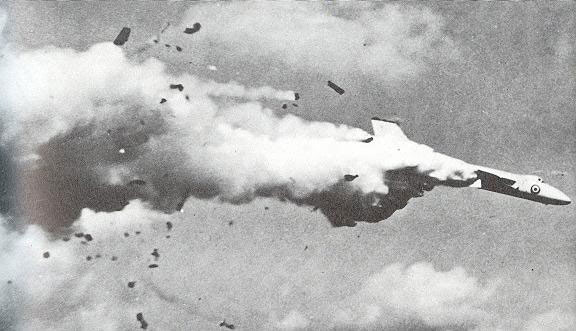Avro Vulcan Delta-Wing Bomber
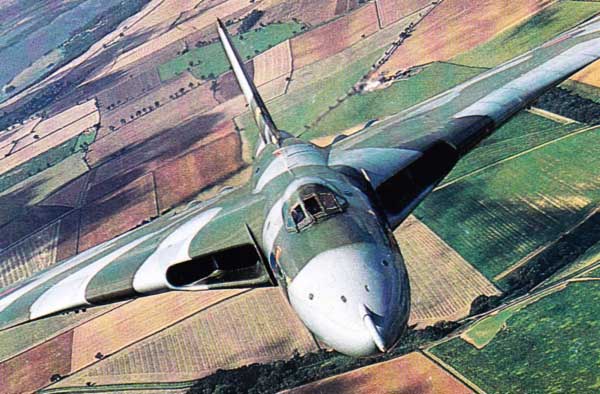
The majestic Avro Vulcan ruled the skies for more than two decades as a major component of the Free World's Cold War nuclear forces. This enormous delta-wing jet was one of the most graceful and beautiful flying machines ever committed to the grim reality of nuclear deterrence. But the Vulcan as lo excelled as a conventional bomber, tanker and reconnaissance platform.
Hawker Siddeley (Avro) Vulcan
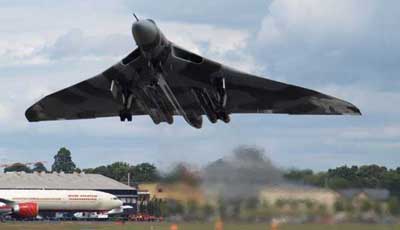
The Avro Vulcan, with its huge I Delta wing, was one of history's most immediately recognizable aircraft, and enjoyed a long and distinguished career in a vitally important role. The aircraft was designed to meet a 1947 Specification for a new strategic bomber. The requirement that resulted in the Avro Type 698 demanded more of an improvement over previous generation bombers than had the requirements which led to the Halifax and Lancaster.
In order to meet the speed, range and bombload figures laid down, the companies who responded to the Air Ministry's specification had to adopt innovative aerodynamic configurations. Avro selected a tailless Delta configuration, and built five sub-scale aerodynamic testbeds as Avro 707s. These were used to explore handling in different parts of the envelope.
As the aircraft were so innovative, there were real fears that one or other of the selected high risk V-bombers might not succeed. Therefore, in addition to the Avro 698 and Handley Page's crescent-winged Victor, the Air Ministry also ordered the Valiant as a stop-gap and 'insurance policy'.
With two competing 'advanced bombers' ordered, as well as an intermediate 'stop-gap', some were surprised that the Vulcan and Victor were not ordered 'off the drawing board'. This would have brought them into service years sooner. Instead, prototypes were ordered and evaluated before production orders were placed.
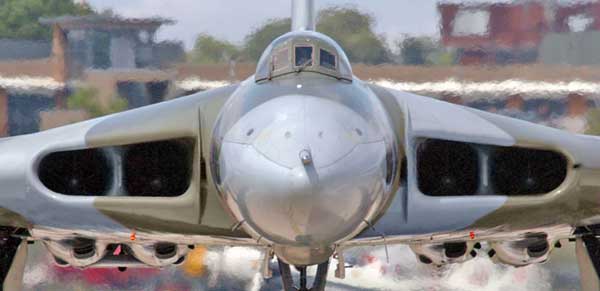
The first Avro 698 made its maiden
flight on August 30, 1952. A few days
later the aircraft stunned audiences at
the Farnborough Air Show in Britain
with an aerobatic display.
With two prototype and two pre-production Vulcans flying, the aircraft
was fitted with a new kinked wing
leading edge, to reduce buffet at high
g. The aircraft also had sufficient flexibility to accept a succession of more
powerful Olympus engines. Soon after
it entered service, the Vulcan B.Mk 1
was capable of cruising at 607mph
(976kmlh) at 50,000ft (15,240m).
This gave the aircraft virtual immuni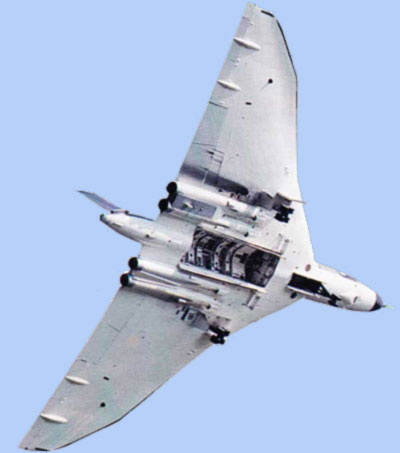 ty from interception.
ty from interception.
The Vulcan B.Mk 1 entered service with No.230 OCU in February 1957, and the first frontline squadron (No.83) formed in July. Only 45 B.Mk 1s were built before production switched to the B.Mk 2 with more powerful 200-series Olympus engines and provision for the new Blue Steel stand-off thermonuclear missile. The B.Mk 2 also had a new redesigned extended span wing, with reduced thickness/cord ratio on the outer panels and with full span elevons instead of the B.Mk 1's separate elevators and ailerons. The new wing was flown on the second B.Mk 1 prototype, before a production B.Mk 2 flew on August 30, 1958. While the adoption of Blue Steel was one reaction to increasingly tough Soviet defenses, another was the provision of advanced ECM equipment in an enlarged and extended tail- cone. This ECM tail was subsequently retrofitted to surviving B.Mk 1s, which thereby became B.Mk 1As, serving until withdrawn from frontline duties in 1967.
The new variant entered service with No.83 Squadron in July 1960, and the new Blue Steel missile followed in 1962. It was subsequently claimed that the introduction of Blue Steel made it possible for Bomber Command alone (with no help from SAC) to destroy "70 per cent of worthwhile targets in the USSR in a single raid".
Even before Blue Steel entered service, plans for its successor were well advanced. The planned Blue Streak, however, was cancelled in April 1960 and was replaced by the US Douglas Skybolt. This was flown by Vulcans in mock-up, inert and instrumented test round form before the US Government cancelled the program.
Meanwhile, the growing effectiveness of enemy SAMs led to a switch to low level operations. These saw the Vulcans receiving a coat of disruptive gray/green camouflage on their upper surfaces, although the undersides remained in glossy anti-flash white.
When Blue Steel reached the end of its operational life in 1969, it marked the end of the V-Force as Britain's strategic nuclear deterrent. This commitment was assumed (from midnight on June 30, 1969) by submarines armed with Polaris missiles. This actually represented a reduction in capability, since 48 available V-Bombers (each carrying a Blue Steel) were replaced by two on-station submarines, each carrying 16 missiles. The Vulcans then switched to tactical nuclear strike and conventional bombing duties, with two squadrons forming a Strike Wing at RAF Akrotiri in Cyprus. The Vulcan remained in service in the bomber role until December 31, 1982.
Its final year conferred an opportunity for making history when two aircraft from No.44 Squadron participated in Operation Corporate (Britain's re-capture of the Falklands) flying long-range bombing and defense suppression sorties from Ascension Island. These missions included laying a stick of 21 1,000 lb bombs across Port Stanley airfield, and hitting enemy radar sites using Shrike missiles. The raids were a powerful demonstration of Britain's ability to hit lone-range targets with impunity. The fact that they were carried out by ar nuclear capable bomber must also have given the Argentinian Junta 'pause for thought'. The Vulcan briefly remained in service in small numbers in the strategic maritime radar reconnaissance and tanker roles. It finally retired in March 1984.

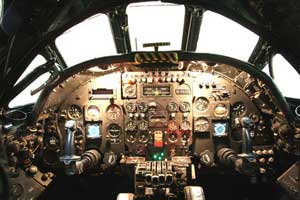 |
Avro Vulcan Cockpit. |
Specifications for the Avro Vulcan
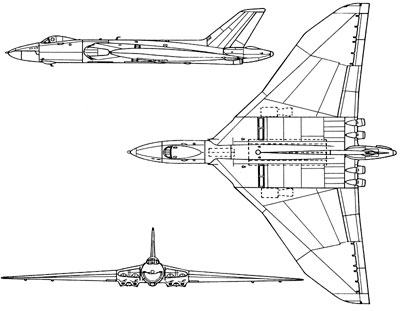 |
Crew: 5 (pilot, co-pilot, AEO, | Navigator Radar, Navigator Plotter) Length: 97 ft 1 in Wingspan: 99 ft 5 in Height: 26 ft 6 in Wing area: 3554 ft² Empty weight: 83,573 lb (including crew) Max takeoff weight: 170,000 lb Powerplant: 4× Bristol Olympus 101, or 102 or 104, with higher thrust turbojet, 11,000 lbf each Performance Maximum speed: 627 mph, 607 mph at altitude Cruise speed: 567 mph at 45,000 ft miles Range: 2,607 mi Service ceiling: 55,000 ft Thrust/weight: 0.31 Armament 21 x 1,000 pounds of conventional bombs 1 x Blue Danube nuclear gravity bomb 1 x Violet Club 400-kiloton nuclear gravity bomb 1 x Yellow Sun Mk.1 400-kiloton nuclear gravity bomb 1 x Yellow Sun Mk 2 400-kiloton nuclear gravity bomb 1 x Red Beard nuclear gravity bomb 1 x Blue Steel rocket-propelled 1.1 megaton nuclear stand-off missile |
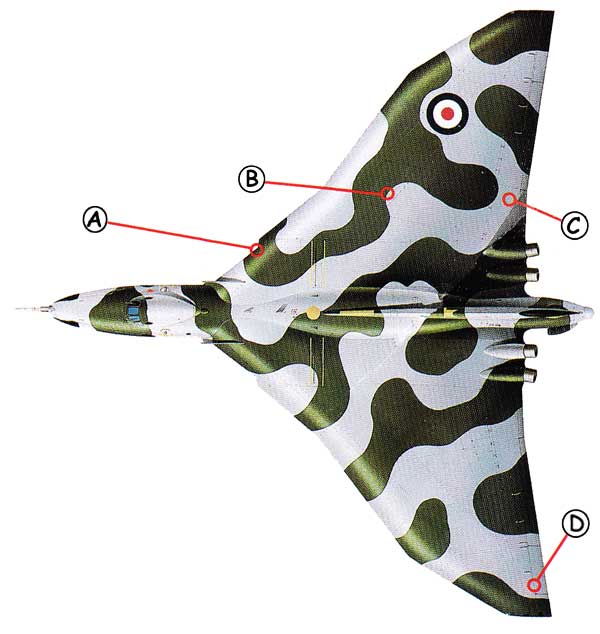 |
|||
| A: Prototype Vulcans had straight-wing leading edges. Production wings were kinked, a feature designed to help eliminate buffeting in high-g maneuvering at altitude. | B: The huge delta wing was the Vulcan's most outstanding feature and made the aircraft highly agile at altitude. | C: Pitch control was provided by four large elevators mounted inboard located between the ailerons and the exhausts of the Olympus turbojets. | D: The Vulcan had no conventional tail, so all control surfaces were on the wing. Roll control was provided by highly effective ailerons mounted outboard. |
 |
||
| A: Vulcan flew with a crew of five. The pilot and copilot sat on ejection seats beneath the canopy. with navigator, air electronics officer and radar operator facing to the rear behind and below the flight deck. | B: The fairing on the tip of the fin housed a passive countermeasures antenna, but most of the defensive electronics were in the tailcone. This also housed a rear-warning radar and twin braking parachutes. | C: During the Falklands War, the inflight-refuelling probe enabled the Vulcan to fly long-range bombing missions against targets more than 4,000 miles away. |
| D: The Vulcan's bombing radar was descended from the World War II H2S set. The six-foot rotating antenna was housed in the underside of the nose. | E: Vulcans carried a total conventional bomb-load of around 21,000 pounds, usually composed of three groups of seven 1,000-lb., general-purpose high-explosive bombs. | F: The Vulcan was powered by four Rolls-Royce Olympus turbojets, each delivering more than nine tons of thrust. The engines were embedded in the wings. |
